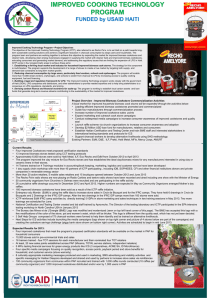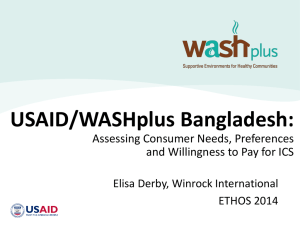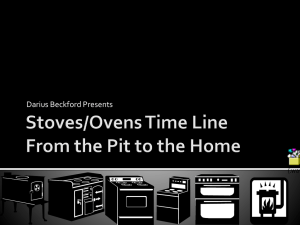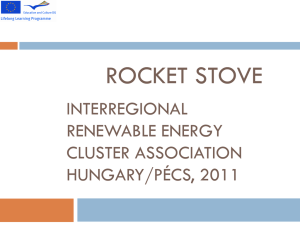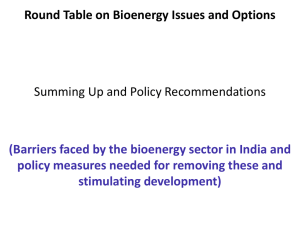PilotPhase-Final-June 13
advertisement
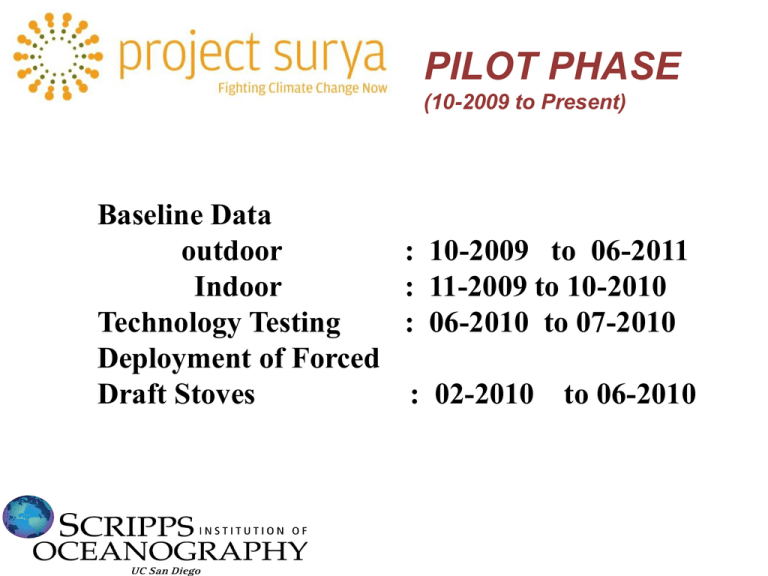
PILOT PHASE (10-2009 to Present) Baseline Data outdoor Indoor Technology Testing Deployment of Forced Draft Stoves : 10-2009 to 06-2011 : 11-2009 to 10-2010 : 06-2010 to 07-2010 : 02-2010 to 06-2010 Experiment Concept 10 km 10 km Pilot Phase MISR NASAAERONET MODIS SURYA Village Center Observatory Traffic-Sample site A Grand Climate and Health Intervention Experiment Technology assessment, dissemination and documentation of emission reduction in the pilot phase The Energy and Resources Institute (TERI), New Delhi, India Cooking technology options LPG Biogas Kerosene Stove Biomass based Improved Cook stove Biomass based Mud Stove Focus: Biomass based IC Even in 2030, 632 million people in • Natural Draft India will depend on biomass for energy In-situ production and consumption • – – Mostly single burner – Enhanced “free convection”- grates, design No expensive LPG like supply chains – Mostly gasification through air pores – Price: 1100-2500 Forced draft – Only single burner – Air “forced” into stove chamber using fan Model/ parameter Thermal efficienc y (%age) Reduct ion in PM2.5 (%age) Reductio n in CO (%-age) Reduction in Black Carbon (%age) Natural draft 20 - 28 20-39 26-34 22-55 Forced draft 30-40 42-55 31-48 49-85 SMF battery power pack, Gasification – Top loading- Processed Fuel, Pellets, rice: $60-80 Strengths • 10% – 25% increase in thermal efficiency • PM 2.5 emissions reduction by a factor of 2-4 Weakness • Field Vs Lab: Performance differential • None of the commercial stoves meet WHO stipulated PM2.5 levels Surya Transition Improved Cookstove Mud Stove Baseline monitoring Testing Development and customization Surya dovetailed an ongoing TERI DST Project which Tested 11 cookstove models Established the advantages of Forced Draft Stoves Reduced cost by 40% Stove dissemination, capacity building Post dissemination monitoring Surya dovetailed an ongoing TERI DST Project which Identified and trained village volunteers Optimized the right mix of fuels for production of pellets Facilitated the setting up of entrepreneurship based pelletization and stove dissemination Surya-Pilot phase Desired Outputs Resources needed (RN) Resources mobilized and spent (RM& S) Activities undertaken till date Contribution of activities undertaken to outputs Pilot testing of different cook stoves models in the Lab In forced draft stoves emission reduction ranges 60-80% Additional resources required (ARR) Technology Identification of appropriate technology options for meeting cooking energy needs Pilot testing of different cook stoves in the field Customized forced draft stove- two pot Comparative assessment of biomass stove technologies focusing both on emission and thermal efficiency characteristics Dissemination of 10 000 forced draft stoves Dissemination of close to 500 forced draft stoves Customized forced draft stove-single pot For Natural draft stoves it is substantially less Thermal efficiency and fuel savings are much higher in forced draft stoves Energy for a Sustainable Future the Secretary-General’s Advisory Group On Energy And Climate Change (AGECC) Summary Report And Recommendations, 28 April 2010, New York Baseline monitoring : Cooking a major source of high BC Concentrations Baseline monitoring : BC Indoor concentrations drive outdoor concentrations TERI Stove development under DST Project • Patented Model • Cost- 2000 – 50% lesser price than comparable commercial model • Dual Charging facility- Grid+ Solar • Separate Power pack • Dissemination to 50 households TERI Stove development under DST (Indian Government) Project Problems with existing single pot models • Requirement of processed wood• Expensive pellets , Manual chopping • Men non inclined, Physically stressful for women • Continuous feeding • Single pot stove- insufficient for big family • Traditional Roti baking • Fuel incompatibility- inability to use non monetized biomass • Hence development of a twin pot forced draft model Surya : Stove dissemination and capacity building • Close to 500 stoves – village saturation • Another 500 stoves under the DST project – Full Subsidy – Partial Subsidy – Full Cost • Training and awareness campaign Forced draft better than natural draft Conclusions Forced draft stoves reduce BC concentrations by 70%-80% Cooking with solid biomass fuels-major source of BC over IGP Peak values early morning and evening hours 100 μg m-3 are a factor of 5 to 20 times larger than day time values Fossil fuel combustion has significant influence on BC conc. Reduction in short lived pollutants by introduction of efficient technologies A Grand Climate and Health Intervention Experiment Wireless System for High Spatial Resolution Data Collection N. Ramanathan UCLA & NexLeaf Monitoring Stove BC Emissions Using Mobile Phones Innovations • $500 per unit, ultra low Micro-Pump and Filter power. • Low-tech: works with any camera cellphone. • Real-time reporting. Filter, placed on reference template Picture sent to server Results sent back via SMS 25 mm N Ramanathan, et al, Atm Environment, 2011 18 Deployment in India for Surya Pilot Phase Validation with four independent gold standard instruments: Error < 10% Cookstove samples collected in India, urabn samples in California (n=80), comparison with Thermaloptical and Aethalometer Cookstove samples collected by the EPA (n=600), comparison with Thermal-optical reflectance and transmittance methods. 20 Global BC Monitoring Network Using Mobile Phones • Will deploy 500 - 1000 cellphones in Surya Demonstration phase to better understand spatial variability of BC • Use this data in conjunction with fine-resolution aerosol models (Prof. Carmichael), to compute BC emissions, and improve uncertainty in emissions inventories. A Grand Climate and Health Intervention Experiment Exposure Implications for Health Impacts from Interventions Results from Preliminary Comparative Assessments of “Improved” and “Traditional” Biomass Cook Stoves in India K. Balakrishnan Department of Environmental Health Engineering Center for Advanced Research on Environmental Health, (ICMR, Govt. of India) World Health Organisation Collaborating Center for Occupational Health Sri Ramachandra University Chennai, India BACKGROUND • Large base of information on concentrations/exposures in solid fuel using households in India, but primarily from traditional (mud) stove users • Previous intervention efforts have been directed at distribution of “Improved Cook Stoves”, without explicit exposure benchmarks for defining improvement • Multiple market based models now being purchased by households • Few efforts to compare “improvements” as compared to traditional cook-stoves and across multiple “ improved“ stoves Study design (Paired comparisons) Indoor Kitchens Using Wood (72 HH; 2 states) 6 sub-groups ; 12 HH in each sub-group 24 hr PM 2.5, CO; HH Questionnaire 6 models of ICS distributed with training (1-2 months) 24 hr PM 2.5, CO (Similar meal); HH Questionnaire ICS1 FRC ICS 2 FRC ICS3 FRC ICS 4 FRC ICS 5 FC ICS 6 FOFC 10% HHs sampled 6 months after ICS provision HH-Household ; TC-Traditional cook stove; ICS- “Improved Cook-stove”; FRC-Free convection ; FC-Forced convection; FOFC : Fuel optimized forced convection Distribution of 24 hr kitchen concentrations TC-Traditional cook stove; FRC-Free convection cook stove; FC-Forced convection; FOFC : Fuel optimized forced convection Comparisons of levels “ before” and “after” PM2.5(µg/m3) Stove Type Total Free Convection Forced Convection and Optimised fuel Forced Convection Levels Base Post Base Post Base Post Base Post N 65 68 44 47 10 10 11 11 Median 300 161 329 187 142.5 105.5 302 99 IQR 533 261 524.5 257.5 231.25 158.5 1347.5 139.5 % Difference p(Wilcox) 46.33 0.002 43.16 0.009 25.96 0.770 67.22 0.032 Levels Base Post Base Post Base Post Base Post N 66 68 45 47 10 10 11 11 Median 5.88 3.40 6.63 3.85 2.79 2.42 6.12 1.32 IQR 8.70 5.69 9.10 5.73 5.36 2.10 9.41 3.89 % Difference p-value(Wilcox) 42.25 0.0001 41.93 0.004 13.37 0.193 78.46 0.007 CO(ppm) Stove Type Total Free Convection Forced Convection and Optimised fuel Forced Convection Summary • Both free and forced convection models showed significant reductions as compared to traditional cook-stoves (ranging between 43- 67%) for both PM 2.5 and CO. • Our sample could not distinguish across improved stove models; detect a significant difference with the fuel optimized free convection model; or detect differences across states • The lowest concentrations measured were however still much higher than the recommended WHO air quality guideline values for PM 2.5 (WHO AQG, Global Update 2005) • Several HH determinants would need to be addressed for longitudinal exposure reconstructions in ICS studies – Stove use/number of meals (frequency) /cooking duration (length) – Stove location, change in fuel, ventilation (magnitude) – Other sources of exposure (confounding) • Role of ambient concentrations would need to be defined Integrated matrices for emissions, exposures and stove use: Implications for sustainability TC Guideline (Choice) FRC Ease of use Emissions FC FOFC ? Guideline (Choice) Exposures TC-Traditional cook stove; FRC-Free convection cook stove; FC-Forced convection; FOFC : Fuel optimized forced convection Note: The chosen guideline is arbitrary on this scale as are the relative positions of the stoves. It is shown to merely illustrate the need to integrate multiple inputs for choosing a technology to confer a required degree of exposure reduction A Grand Climate and Health Intervention Experiment Climate Change Science V. Ramanathan On behalf of the Climate Change Team Seasonal and Diurnal Variation in BC Concentrations: Surya Village Center Diurnal variation of seasonal mean BC concentration at SVI_1 village centre (VC). Seasonal Variation in BC Concentrations: Comparison with Climate Models Simulated Ganguly et Al, 2010 Simulated Menon et al, 2010 Diurnal variation of seasonal mean BC concentration at SVI_1 village centre (VC). How Deep Does the Soot aerosols Penetrate? NASA-CALIPSO Data OCT to NOV DEC to FEB March to May Monthly mean LIDAR extinction profiles (532 nm) from CALIPSO for the grid (26–27N and 80–82E) for post-monsoon, dry and pre-monsoon seasons, respectively. SVI_1 is located within this grid. Detection of Brown Carbon Absorption Absorption Coefft Brown Carbon ? Relevance to Larger Scale Correlation Between Surya Village and Indo-Gangetic Plains Atmospheric Heating by Aerosols: (About 60% or more is due to biomass burning) Potential Signal Strength of the Intervention Wrap-up for Findings from the Surya Pilot Phase ๏ Cooking drives local outdoor BC concentrations. ๏ Forced draft stoves are best from a BC mitigation perspective. ๏ We can measure surface BC emissions with unprecedented spatial resolution. ๏ We will be able to measure the BC hole from Surface Based measurements and Generalize to Regional Scales • Should be able to Detect it from Space; But a great Challenge; But NASA is upto it ( Dr. R. Kahn, Goddard) A Grand Climate and Health Intervention Experiment Sustainability: Affordability and Acceptable Adoption Subhrendu Pattanayak Duke University Meta Analysis of Stove Adoption %+ 50% 3 100% 6 9 67% %- 67% % ~ 50% 33% 2 2 9 2 100% 50% 67% 50% 50% 100% 33% 50% 33% 3 2 Electricity $ LPG$ Kerosene$ Coal$ Wood$ Wood? Credit 2 Income 2 HH Size Male Educ. N Fem. Educ. X HH InCredi Energy Access / Supply Char. come t Low Caste Personal Char. 2 33% 100% 50% 67% 50% • 11 Analyses (8 papers) • SES, Income, Credit, substitute prices matter! • Similar findings for meta-analysis (140 analyses from 25 studies) of switching to clean fuels Scaling up: Some Findings! I. Who adopts clean fuels and improved cook stoves? (Lewis & Pattanayak) – SES, education, prices, urban – matter – credit, information campaigns, social marketing – not studied II. What factors explain PCIA program location and stove sales? (Colvin, Pattanayak, Sasser, Vergnano) – sales impacted by institution (government, location) & product (price, testing) characteristics – providers currently in countries with problems (biomass burning, ARI) and prospects (already spending on health programs) III. Will cook stove programs be cost-beneficial is a wide variety of settings? (Jeuland & Pattanayak) – cost-beneficial stove programs exist, but – substantial heterogeneity of NPV for different stove types


